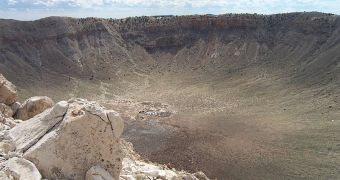A massive extinction event that occurred at the end of the Triassic Period still has researchers baffled. It represents one of the most mysterious mass dyings in the history of the planet, and some believe that it was caused by an asteroid. Scientists are currently looking for a potential impact crater.
The event occurred roughly 199.6 million years ago, and saw twenty percent of all marine families disappear, alongside an entire class (conodonts) of sea-faring creatures, disappear from the water. All non-dinosaurian archosaurs were wiped out from the land.
The only exceptions were a few large amphibians, crocodilians and some therapsids. In all, more than half of all species that were alive at that time were wiped out, never to recover again. This had the major implication of opening up new habitats for dinosaurs to occupy and dominate.
But how did this event come to pass, and what caused it? These questions could be answered if experts were to find an impact crater coinciding with the exact time of the extinction event. Supervolcano eruptions and catastrophic climate change are also leading candidates.
Studies conducted thus far have revealed interesting, widespread disruptions in ecosystems around the planet, dating back to around 200 million years ago. These clues were found in geological formations identified all over the world.
Near the Antrim coast of Northern Ireland, scientists from the Columbia University and Rutgers University recently began sampling a series of special cliffs and rocks, which reveal the T-J boundary in detail, Space reports.
One of the most interesting things the team found was that the layers of sediments belonging to this event were distorted and rippled, as if something shook and stirred them up. “The scale of the disruption is huge, and a huge cause seems likely,” Columbia University expert Paul Olsen says.
The disruption is not localized to the UK, but also extends to Belgium, and possibly even Italy. This decreases the chances of it being caused by a massive earthquake, and increases the likelihood that an asteroid or other space impactor was to blame.
The issue here is that no such large crater is known to exist, so as to explain the massive destruction. Soils, forests, rivers, winds, sand and new seas and oceans can easily erode even a large crater in its entirety over such a long time, leaving no tracks behind.
Researchers plan to continue their investigations in the UK and at other locations for the conceivable future, in hopes of finding a crater that could explain the T-J event. If this line of study does not pan out, then scientists will return to square one, and try to find an entirely different explanation for what happened.

 14 DAY TRIAL //
14 DAY TRIAL //